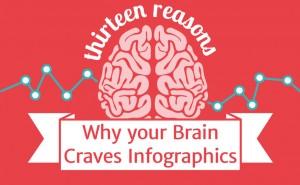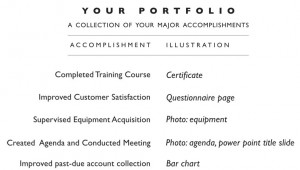A web-based portfolio is your creative suitcase and a critical part of your web presence. Pack it carefully and your portfolio becomes the visual component of whatever story you want to tell. The creativity that you unleash by packaging your portfolio will spark further innovation. Protect that spark. It may well be what your current or future boss values most.
Your Portfolio.
My co-workers are often surprised when I ask them if they’ve gathered photographs and other work samples for their portfolios. They think that’s just something that designers do, and that the word “portfolio” is only relevant to the world of commercial art. Is it also relevant to contributors and managers in a federal organization?
You bet. But a portfolio can be so much more than just a collection of work samples. It can be the emblem of creativity in your career campaign.
There are a few alternate meanings to the word. A portfolio can mean an investment portfolio, a bundle of products and services, or, chiefly in the UK, the responsibilities of a member of a legislature, a government department or ministry.
Portfolios are everywhere.
Now that you’re sensitized to it, the word “portfolio” will appear to be everywhere. Venture capital companies in U.S. technology corridors have created “startup career portfolios,” indexes of jobs and projects for those who want to sell themselves to startup companies. A holding company called WGL is a diversified energy business providing natural gas, electricity, green power, carbon reduction and energy services. I saw one of their ads on the Metro this morning. It trumpeted the breadth of their “energy portfolio,” and briefly listed all the energy types that they supply.
You will find that “portfolio” is an extremely useful word to describe a collection of related items, packaged for consumption by a target audience. So organizing a portfolio of your qualifications, skills, and experience is a pretty mainstream idea.
The idea of career portfolios for federal directors, specialists, and everything in between isn’t brand new. But it’s new enough to be innovative. “Project portfolio management” has emerged as an established and well-regarded methodology, and “career portfolio” has become a term of the craft.
# # #
I mentioned that some of my co-workers disdain commercial art. Forward-thinking communicators don’t sneer at it. After all, the words simply refer to design that is created in the service of business. Commercial art also serves the mission of your agency, your work group, and you as an employee and a private individual.
Some public servants may be fearful that emulating a designer will make their fact-based achievements seem less important. But it may be that just the opposite is true.
Think like a designer.
“Design Thinking,” a management concept that’s currently hot, is a practice in which government and commercial managers experiment with methods used by designers to generate ideas. It has been common for a long time to speak in terms of “left-brain” creatives and “right-brain” quantifiers. The latest science says that there’s a lot of dual-lobe thinking and that dividing the brain into left and right is a simplistic and inaccurate model for understanding how our minds work. Nonetheless, it’s useful shorthand to say that right-brain administrators can open themselves to fresh ideas by exercising the side of their brains that don’t often dominate.
Build your book.
In the old days, designers carried very large zippered cases in which samples of their work were protected between plastic pages. The designer’s jargon for the portfolio is “book,” as in “Can I show you my book?” The traditional routine was to sit with the prospective client or employer and turn the pages as you narrate your story, calling the client’s attention to specific design samples that move the narrative along.
There’s a scene in Kramer vs. Kramer (an old movie) where Dustin Hoffman frantically shows his “book” as he migrates from ad agency to ad agency, begging to get hired and struggling to be heard above the boozy chaos of holiday parties in full swing. We get to hear him “narrate” his book again and again. His frustration mounts as each agency expresses disinterest and tells him that there’s no room at the inn. Finally, one ad manager sees his book, hears his story, and says, “Yes, you’re hired.”
My point is that if you own the book, you own the story that you tell to the person you’re persuading—to give you a job, put you in charge of a project, buy a product, or sign up for a service. And “the book” is a display of your achievements that both explains and backs up your capabilities.
Now, your book is digital. You need to decide how you’ll provide entrée from the rest of your website so that the portfolio can be seen. You also need to decide how you’ll organize your work samples.
The online portfolio that’s part of your web presence should include graphic representations and descriptions that display your work and accomplishments, even if there is no obvious graphic content in your work product.
If you are at a loss as to how your achievements can be illustrated, reflect a bit. After quiet contemplation, you may be able to see how the factual, right-brain qualities of your work might be effectively communicated using illustrative methods that are usually the province of the left side of your brain. A conventional version of this might be a simple line chart, bar chart, pie chart, Pareto chart or scatter diagram. But the family called “information graphics” offers a wealth of data displays with immediate visual appeal. You see information graphics frequently in newspapers and periodicals.

Entertaining, informative, and with plenty of ideas for enlivening the quantitive content in your portfolio.
Here’s a charming and informative set of visuals called “13 Reasons Why Your Brain Craves Infographics,” created by NeoMam Studios. http://neomam.com/interactive/13reasons/
The graphics you use in your portfolio are not meant to be self-explanatory, they are intended to stimulate a conversation that you will guide. A portfolio that tells a good story can be an excellent selling tool for your customer, boss or hiring manager. If you keep them in mind as your “agents” when you build your book, you’ll find that your portfolio will help them sell their customer, boss or other manager on you and what you have to offer.
Designer-style.
How do designers package themselves? Now, portfolios are created, presented and evaluated online, not in cumbersome books. From an e-mail or web page, designers provide a link to work samples that their prospective customers can review. There’s another design opportunity here in the design of the container for the samples—how the samples are packaged, captioned, sequenced and indexed.
Work samples for writers.
Written work samples are an important part of your digital portfolio. You’ll need to collaborate with a designer or be facile enough in design to produce a visual format for organizing the samples. The visual format should look professional and not detract from the writing samples themselves.
I would advise any writer to provide his or her three best samples; three and no more. But I have trouble following my own advice. Once I start choosing and organizing my writing samples, all reason and restraint go out the window. I have thoughts like, “This was a series of articles. How will they know it’s a series if I only show them one sample? “I can’t leave this one out. It’s the only sample I have that’s (fill in the blank—lighthearted, serious, somber, wacky, different). If I don’t include it, how will they know that I write in this vein, too?
Now we come to you.
You can borrow from the portfolio concept to build a visual display of some of your greatest accomplishments. To do this, find or create an image for each major accomplishment you want to feature. Take a look at some of the suggestions below; you’ll have your own idea of how to illustrate each of your key points. Then, sequence and enhance these images in PowerPoint, Prezi, Keynote or other presentation software. Linked to your hub, and packaged in a way that supports your USP (Unique Selling Proposition), this visual tool can be a fine representation of your achievement highlights. It also demonstrates your command of both verbal and visual aspects of communication.
Snapshots taken with your smart phone should yield an adequate representation of your accomplishments. (Unlike your photographic portrait, which needs professional equipment, a studio, and a trained photographer.) Remember, the image just has to suggest the accomplishment, especially if you add text. It doesn’t have to show every individual feature. And, since you control the tempo and will show only those samples you choose, you can tell any story you choose to accompany it.
As you continue to add accomplishments to your portfolio, you’ll become increasingly aware of visual touchstones or other representations to help you dramatize your key accomplishments—for use in your current job, your next job, or as backup during your next performance review. Get in the habit of collecting “souvenirs” of your various projects. By that I mean a page or two from a report, a PowerPoint slide, an agenda, even personalized name tags and place cards, anything that establishes a visual record of your contribution to and participation in a noteworthy event.
I like to save the ID badges I’m issued when I attend a conference. They make a nice collage to show off some of my professional development. Colorful and interesting to look at, they’re one of the most visually attractive elements of my portfolio.
You no longer have to go to an art supply store to buy a huge portfolio book. The contemporary equivalent is a major spoke in the wheel of your web presence. There are many ways to incorporate your portfolio samples into your website. I suggest you start small. If you create a short PowerPoint presentation that features three to five accomplishments, three to five visual elements to represent and add excitement to them, all on three to five slides, you’ll have a solid core message to anchor your web presence and keep your text on track and consistent with the “official words.” I find myself returning to my own “official words” pretty frequently. I save the labor of composing the content from scratch; more importantly I reinforce the key ideas by repeating the same phrasing time after time.
# # #
We are bombarded—and it is a happy bombardment—by business publishers declaring that creativity is the characteristic most sought-after by employers.
Controlled Weirdness.
Creativity has been widely studied. The dean of creativity science was Frank X. Barron, an Emeritus Professor at the University of California (UC) at Santa Cruz, who was best known for his intensive studies of highly creative people conducted at UC Berkeley. Dr. Barron once described creative people as “both more primitive and more cultivated, more destructive, a lot madder and a lot saner than the average person.” He also referred to creativity as “controlled weirdness,” which seems as good a definition as any. The term could describe a brainstorming session in which participants are free to say anything they want, present any idea that emerges, in a comfortable and safe environment established with one rule—that no idea would be subject to judgment.
“We are all innately creative, we all solve problems, produce ideas and think unusual thoughts,” says Mark Batey, an editor of the International Journal of Creativity and Problem Solving. No less an authority on creativity than Pablo Picasso said that we are all born artists, but spend the rest of our lives forgetting what we know about creating art. Sir Ken Robinson, author of “Out of Our Minds: Learning to be Creative,” says that we don’t grow into creativity, we grow out of it. So a large part of marshalling our creativity in the interest of public service, or commerce, or education is to reach back to a time in our lives when we weren’t afraid to be wrong, to take chances, to play with ideas.
Psychology Today published an article titled, “Is Creativity the Number One Skill for the Twenty-First Century?” Citing multiple research studies, their analysis concluded, in part, that creativity is vital from the shop floor to the boardroom and at the level of the individual to the organization as a whole. What is more, our economic fortunes at a societal level probably rest on creativity too.
IBM conducted a study of 1,500 chief executives from 60 countries and 33 industries. The executive summary of the study bore the headline, “Creativity Selected as Most Crucial Factor for Future Success.”
Other highlights from the report quote some of the CEOs on key characteristics of creative leaders. Among them: “Creative leaders invite disruptive innovation,” encouraging others to drop outdated approaches and take balanced risks.”
There are all kinds of ways to be creative. You can start with little steps and a modest scope. You’ll find that by simply talking to people—your stakeholders, bosses, clients and customers, as well as your colleagues—the concept of creativity will be on the table and you can begin to exchange some ideas. It takes guts to be a “change agent,” and you may not see yourself as a crusader for creativity. But can it be a bad thing to promote dialogue, to foster communication? Who knows what might come from your conversations about creativity?
Even if you chose to be an advocate for creativity and innovation, you’re not going to change the culture of your organization overnight. You may not be in a position to change the organization at all. But you can change one aspect of the culture—you—and encourage creativity across your span of control. Even if the span is limited to one person.
What do creative people look like?
This was the provocative title of an article by Mark Batey for the Creative Leadership Forum. (The forum builds its messages around the words Collaborate, Create, Commercialise. (SIC—they’re in the UK.) Naturally, the article states that creative people don’t look any different than the rest of us. I both agree and disagree with Mark. The ubiquity of information technology means that the tools of creative work (a laptop, for example) are the same tools used in finance (a laptop, for example). Since tools are no longer a clue to someone’s occupation, it is harder to spot creatives by their accessories. And your guess is as good as mine when it comes to people clad entirely in black.
But in some industries, like advertising, the great divide still exists. That’s unfortunate because it perpetuates the stereotype that those who are not in the creative professions can’t be creative, which is manifestly not true.

One’s a Creative. The other one’s a Suit. And the man in the middle? The once rigidly-drawn lines between Suits and Creatives are beginning to blur.
The great divide.
The great divide still persists. In the traditional advertising realm of copywriting and design, the world is cleaved neatly in two. The two types of humans are (a) creatives and (b) suits. Remnants of that thinking still exist. But the enlightened understand that “suits” can be creative, too. Management, measurement, leadership, business, administration—all are brimming with opportunities for creativity. The residue of the bifurcation can be found in the language—designers of all stripes, copywriters, illustrators, video artists—all consider themselves creatives. (Note that creative is a noun in this case.) The adjective creative is now available to anyone who exhibits creativity—no matter what they wear to the office. Even a suit.
# # #
J.T. Kerwin has been writing about information technology since the dawn of the personal computer—starting with ad copy for the first Chicago dealer of the IBM-PC. Later, as a communication strategist with Xerox, he was among the earliest users of the original mouse, icons, Ethernet and e-mail. He has created brand identities for IT spinoff companies, startups and programs within the federal government. J.T. is now a brand strategist for a federal agency that sells security products in a competitive environment. His blog posts reflect his background in creative communication, language and design. J.T. believes that everyone can discover their inherent creativity and develop their own brand personality—contributing more to their federal mission and accelerating their own success.






Leave a Reply
You must be logged in to post a comment.